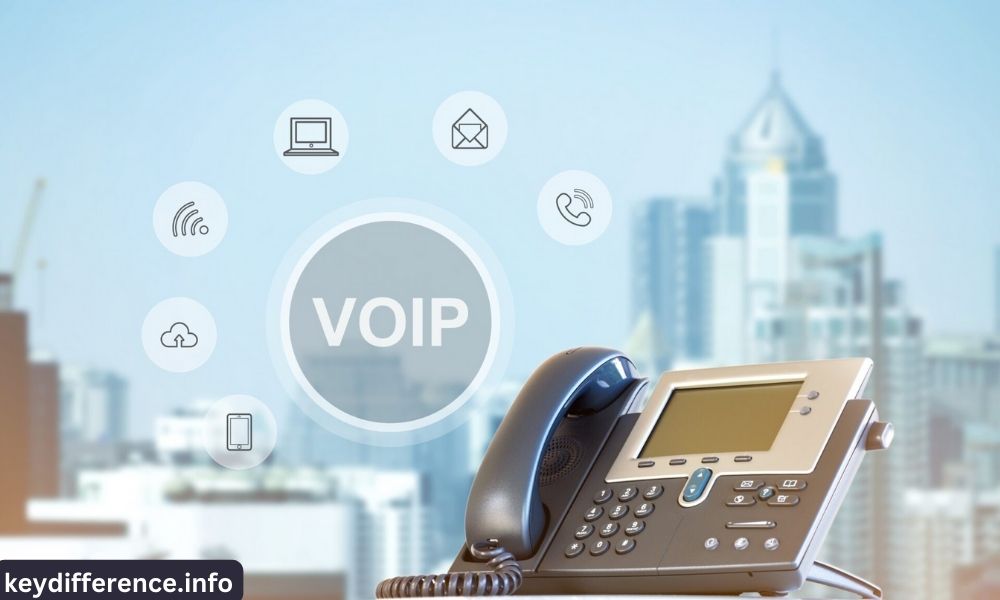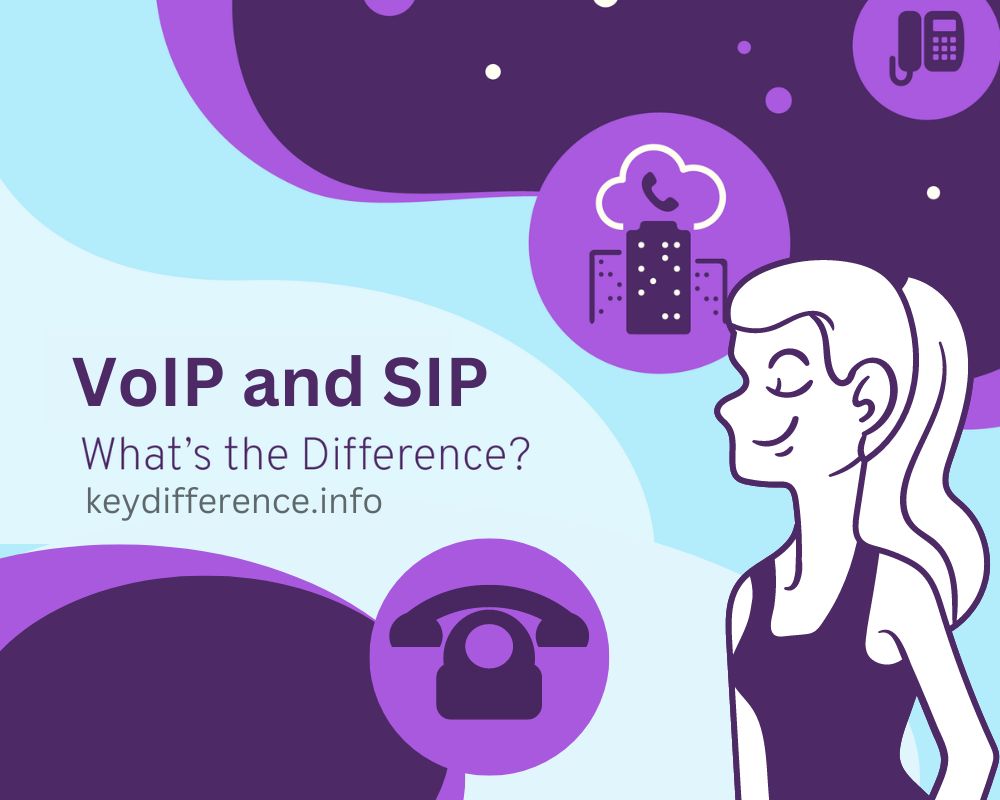Introduction to VoIP and SIP
VoIP, which stands for Voice over Internet Protocol, is a technology that allows voice communication to be transmitted over the Internet rather than traditional telephone networks. It converts analog audio signals into digital data packets, which are then transmitted over IP networks. This enables voice communication to be integrated with other Internet-based applications and services.
One of the key protocols used in VoIP is SIP, which stands for Session Initiation Protocol. SIP is a signaling protocol that is responsible for establishing, modifying, and terminating sessions between participants in a communication session.
It is an application-layer protocol that operates in conjunction with other protocols, such as Real-time Transport Protocol (RTP), to enable real-time voice and multimedia communication.
SIP provides a framework for various features and functionalities in VoIP, including call setup, call termination, call transfer, call forwarding, and presence. It also supports multimedia communication, allowing the transmission of voice, video, instant messaging, and other data types.
SIP operates based on a client-server model, where user agents (UA) initiate and terminate sessions by sending SIP requests to SIP servers. SIP servers can be categorized into several types, including proxy servers, redirect servers, and registrar servers. Proxy servers route SIP requests, redirect servers provide information on how to reach a user, and registrar servers maintain user location information.
When a user wants to establish a VoIP call, the SIP client (user agent) sends an INVITE request to the SIP server, specifying the address of the callee. The server then locates the callee and sends a series of messages to establish the call. Once the call is established, the voice data is transmitted using RTP, while SIP continues to manage the call session.
SIP is a widely adopted protocol and is used in various VoIP applications and services, including IP telephony, video conferencing, instant messaging, and unified communications. It provides flexibility, scalability, and interoperability, allowing different devices and platforms to communicate with each other seamlessly.
VoIP and SIP revolutionize the way voice communication is delivered by utilizing the power of the Internet. VoIP enables voice transmission over IP networks, while SIP facilitates session initiation, modification, and termination.
Together, they form the foundation for modern voice communication systems, offering cost-effective and feature-rich alternatives to traditional telephony.
What is VoIP?

VoIP stands for Voice over Internet Protocol. It is a technology that enables the transmission of voice and multimedia communication over internet-based networks. Instead of using traditional analog phone lines, VoIP converts voice signals into digital data packets and sends them over IP networks.
At the destination, the packets are reassembled and converted back into voice signals. VoIP allows users to make calls from a variety of devices, including computers, smartphones, and IP phones, using internet connectivity.
It offers several advantages over traditional phone systems, including cost savings, scalability, flexibility, and integration with other communication services. VoIP has become increasingly popular in both residential and business settings, providing a more efficient and cost-effective alternative to traditional telephony.
How VoIP works
VoIP works by digitizing voice signals, compressing them into data packets, and transmitting them over IP networks. It utilizes codecs (coder-decoder) to convert analog voice signals into digital format and back for transmission. The packets are routed through IP networks to reach the recipient, where they are reassembled and converted back into voice signals.
Benefits of VoIP
- Cost savings: VoIP often offers lower costs for voice communication, especially for long-distance and international calls, compared to traditional telephony.
- Flexibility and scalability: VoIP systems are flexible and can adapt to changing business needs. They can easily scale up or down to accommodate increased or decreased communication requirements.
- Enhanced features: VoIP provides various advanced features like call forwarding, voicemail, video conferencing, virtual phone numbers, and integration with other applications like CRM systems.
Examples of VoIP applications and services
- Business phone systems: Many businesses use VoIP for their internal and external communications, replacing traditional PBX systems. This includes features like auto-attendants, call routing, and conference calling.
- Residential phone services: Some individuals opt for VoIP services as an alternative to traditional landline phones. These services often offer cost savings and additional features.
- Mobile applications: VoIP technology is also used in mobile applications like voice and video calling apps, enabling users to make calls over the internet using their smartphones.
Understanding VoIP lays the foundation for comprehending its underlying protocols, including SIP, and how it revolutionizes communication systems.
What is SIP?

SIP, which stands for Session Initiation Protocol, is a signaling protocol used for initiating, modifying, and terminating real-time communication sessions. It is an application-layer protocol that operates in the Internet Protocol (IP) suite, enabling multimedia communication such as voice, video, instant messaging, and other real-time interactions.
SIP serves as a foundation for communication in Voice over IP (VoIP) systems and is widely adopted for establishing and managing communication sessions over IP networks. It provides the necessary signaling to set up and control sessions between two or more endpoints typically referred to as User Agents. User-Agents can be hardware devices like IP phones or software applications running on computers or mobile devices.
How VoIP works
VoIP technology employs a series of steps to transmit voice signals over IP networks:
a. Analog-to-digital conversion: Voice signals are converted into digital format using analog-to-digital converters.
b. Packetization: The digitized voice signals are divided into small data packets, typically using the Real-Time Transport Protocol (RTP).
c. Compression: To optimize bandwidth utilization, voice packets are compressed using codecs, such as G.711 or G.729, which reduce the size of the packets without significant loss of quality.
d. IP network transmission: The compressed voice packets are transmitted over IP networks, such as the internet, using the Internet Protocol (IP).
e. Packet routing: Voice packets are routed through IP networks using routers and switches until they reach the recipient.
f. Reassembly and decoding: Upon arrival, the packets are reassembled and converted back into analog audio signals using digital-to-analog converters.
Applications of VoIP
VoIP finds applications in various domains, including:
a. Business communications: Many businesses use VoIP for their internal and external communications, enabling features like conference calling, call routing, and unified communications.
b. Residential services: VoIP services are increasingly popular for residential phone lines, providing cost-effective alternatives to traditional landline services.
c. Mobile applications: VoIP technology is utilized in mobile applications, enabling voice and video calling over the internet via smartphones and other mobile devices.
Understanding VoIP helps individuals and organizations harness the benefits of this technology for efficient and cost-effective communication.
Comparison Table of VoIP and SIP
Below is a comparison table highlighting the key differences between VoIP and SIP:
| Feature | VoIP | SIP |
|---|---|---|
| Definition | Technology for transmitting voice over IP | Protocol for session initiation in VoIP systems |
| Scope | Broad concept encompassing voice and media | Specific protocol for session initiation |
| Functionality | Enables voice and multimedia communication | Initiates, modifies, and terminates sessions |
| Communication Modes | Voice, video, instant messaging, and more | Voice, video, instant messaging, presence |
| Scalability | Highly scalable and adaptable | Supports scalability and growth |
| Integration | Integrated with other systems and devices | Integration with various communication modes |
| Interoperability | Supports interoperability between systems | Ensures compatibility between SIP devices |
| Network Complexity | May require configuration and optimization | Configuration needed for optimal performance |
| Security | Encryption, authentication, and firewalls | Vulnerable to security threats if not secured |
| Emergency Calling | May have limitations for emergency calling | Can be configured to support emergency calls |
| Cost | Cost-effective compared to traditional PBX | Additional costs for SIP-enabled devices |
Similarities Between VoIP and SIP

VoIP & SIP are closely related and often used together in real-time communication systems. While they have distinct roles and functionalities, there are several similarities between VoIP & SIP.
Here are some key similarities:
IP-Based Communication
- Both VoIP & SIP are based on the Internet Protocol (IP).
- They leverage IP networks, such as the internet or private IP networks, for transmitting voice and multimedia communication.
Real-Time Communication
- Both VoIP & SIP enable real-time communication between users.
- They facilitate voice calls, video calls, instant messaging, and other real-time interactions over IP networks.
Efficiency and Cost Savings
- Both VoIP & SIP offer cost-saving advantages compared to traditional telephony systems.
- By utilizing IP networks, they eliminate the need for dedicated phone lines, resulting in reduced communication costs.
Device and Location Independence
- Both VoIP & SIP allow users to communicate from various devices and locations.
- Users can make calls or engage in multimedia communication using IP phones, softphones, computers, smartphones, or other devices with internet connectivity.
Scalability and Flexibility
- Both VoIP & SIP provide scalability to accommodate growing communication needs.
- They allow for easy expansion of user endpoints and support flexible deployment options, including on-premises, cloud-based, or hybrid setups.
Integration with Other Services
- Both VoIP & SIP can integrate with other communication services and protocols.
- They can work alongside protocols like HTTP, SMTP, XMPP, and others to enhance communication features and integration with web-based applications.
Support for Multimedia Communication
- Both VoIP & SIP support multimedia communication, including voice, video, and instant messaging.
- They enable users to engage in various types of communication sessions and collaborate using different media formats.
Interoperability
- Both VoIP & SIP promote interoperability among different vendors, devices, and systems.
- They adhere to standards and protocols, allowing for seamless communication between VoIP/SIP-based solutions from different providers.
While VoIP is a broader concept that encompasses the transmission of voice communication over IP networks, SIP is a specific protocol used within the VoIP framework for session initiation and management. Understanding the similarities and differences between VoIP and SIP is crucial for effectively implementing and utilizing these technologies in communication systems.
Real-World Examples and Use Cases
Real-world examples and use cases of both VoIP and SIP illustrate their practical applications and how they are utilized in various contexts.
Here are some examples:
VoIP Use Cases
Business Phone Systems
Many businesses utilize VoIP for their internal and external communications. They replace traditional PBX systems with VoIP-based solutions, enabling features such as auto-attendants, call routing, voicemail, and collaboration tools.
Residential Phone Services
VoIP services are increasingly popular for residential phone lines, offering cost savings and additional features like call forwarding, virtual phone numbers, and voicemail-to-email transcription.
Mobile Applications
VoIP technology is widely used in mobile applications for voice and video calling. Popular examples include applications like Skype, WhatsApp, and FaceTime, which enable users to make calls over the internet using their smartphones.
SIP Use Cases
VoIP Call Initiation and Termination
SIP plays a critical role in initiating and terminating VoIP calls. It handles the establishment, modification, and termination of communication sessions between SIP-enabled devices, ensuring proper call setup and tear-down.
Instant Messaging and Presence Services
SIP can be used for instant messaging and presence services, enabling real-time text-based communication and indicating the availability or status of users. This allows for efficient collaboration and communication in various applications.
Video Conferencing and Collaboration
SIP facilitates video conferencing and collaboration by establishing and managing multimedia sessions. It enables multiple participants to join virtual meetings, share audio and video streams, and collaborate on shared documents or screens.
These real-world examples demonstrate how VoIP and SIP are applied in different contexts, empowering businesses and individuals with cost-effective, feature-rich communication solutions and enabling seamless collaboration across various devices and platforms.
Pros and Cons of VoIP
VoIP (Voice over Internet Protocol) offers numerous advantages and benefits, but it also has some potential drawbacks.
Here are the pros and cons of VoIP:
Pros of VoIP
- Cost Savings: VoIP often provides significant cost savings, especially for long-distance and international calls. It leverages the internet infrastructure, eliminating the need for separate voice and data networks and reducing communication expenses.
- Flexibility and Scalability: VoIP systems are highly flexible and easily scalable. They can accommodate changing business needs, allowing organizations to add or remove users and adjust their communication resources as required.
- Rich Features: VoIP offers a wide range of advanced features and functionalities that enhance communication efficiency. These may include call forwarding, voicemail, video conferencing, call recording, auto-attendants, virtual phone numbers, and integration with other applications or systems.|
- Mobility and Accessibility: VoIP enables users to make and receive calls from anywhere with an internet connection. It provides mobility and accessibility through softphone applications, which can be installed on laptops, smartphones, or tablets, allowing users to connect to their VoIP systems remotely.
- Integration and Unified Communications: VoIP can integrate with other communication tools and systems, enabling unified communications. It allows for the convergence of voice, video, instant messaging, presence, and collaboration into a single platform, enhancing productivity and collaboration.
Cons of VoIP
- Internet Dependence: VoIP relies on a stable and reliable internet connection. If the internet connection is weak or unstable, it may result in poor call quality, dropped calls, or interruptions in communication.
- Power Dependency: VoIP systems require a continuous power supply. In the event of a power outage or network disruption, VoIP services may be unavailable unless backup power solutions are in place.
- Emergency Calling Limitations: Unlike traditional landline phones, VoIP may not provide the same level of reliability and location accuracy for emergency calls (911). It is essential to ensure that emergency calling services are properly configured and tested for VoIP systems.
- Call Quality and Bandwidth: VoIP call quality can be affected by network congestion, bandwidth limitations, or inadequate network configurations. It is crucial to have sufficient bandwidth and prioritize VoIP traffic for optimal call quality.
- Security Concerns: VoIP can be susceptible to security threats such as unauthorized access, eavesdropping, or denial-of-service (DoS) attacks. Implementing proper security measures, such as encryption, firewalls, and regular updates, is essential to mitigate these risks.
Understanding the pros and cons of VoIP helps individuals and businesses make informed decisions regarding its adoption, taking into account both the benefits and potential challenges associated with this technology.
Pros and Cons of SIP
SIP (Session Initiation Protocol) is a widely used protocol for initiating, modifying, and terminating communication sessions within VoIP systems.
Here are the pros and cons of SIP:
Pros of SIP
- Flexibility and Interoperability: SIP is a highly flexible and extensible protocol that enables interoperability between different communication systems and devices. It allows for seamless communication between SIP-enabled devices and supports a wide range of multimedia applications and services.
- Scalability: SIP-based systems are scalable, making it easier to add or remove users and expand the communication infrastructure as needed. This scalability enables businesses to adapt to changing communication requirements without significant disruptions.
- Call Control and Session Management: SIP provides robust call control and session management capabilities. It allows for call setup, termination, and call transfer, as well as advanced features like call hold, call waiting, and call forwarding. SIP also supports session negotiation and modification for multimedia sessions, enabling real-time collaboration.
- Support for Advanced Services: SIP facilitates the integration of advanced services such as video conferencing, instant messaging, presence, and unified communications. It enables the convergence of different communication modes into a single platform, enhancing productivity and collaboration.
- Standardization and Wide Adoption: SIP is a standardized protocol recognized and supported by a wide range of vendors and service providers. Its widespread adoption ensures compatibility and interoperability, making it easier to integrate SIP-based systems and services.
Cons of SIP
- Network Complexity: SIP-based systems can be complex to set up and configure, especially in large-scale deployments. Proper network infrastructure and configuration are essential to ensure optimal performance and call quality.
- Reliance on Internet Connectivity: Similar to VoIP, SIP relies on a stable and reliable internet connection. Any issues with the internet connection can impact call quality and reliability.
- Security Considerations: SIP-based systems may be vulnerable to security threats, such as unauthorized access, call interception, or DoS attacks. Implementing proper security measures, including encryption, authentication, and firewalls, is crucial to protect against these threats.
- Compatibility Challenges: Despite standardization efforts, there can be compatibility challenges between different SIP implementations. It is essential to ensure compatibility between SIP devices, applications, and service providers to avoid interoperability issues.
- Emergency Calling Limitations: Similar to VoIP, SIP may not provide the same level of location accuracy and reliability for emergency calls (911) as traditional landline systems. Proper configuration and testing of emergency calling services are necessary to address this limitation.
Understanding the pros and cons of SIP helps organizations assess its suitability for their communication needs, taking into account its advantages and potential challenges. Proper planning, implementation, and ongoing maintenance are essential to maximize the benefits of SIP-based systems.
VoIP and SIP Find the Perfect Match for Your business
When considering VoIP and SIP for your business, it’s important to understand their relationship and how they complement each other. VoIP is the broader concept that encompasses the transmission of voice and multimedia content over IP networks, while SIP is a specific protocol used for session initiation, modification, and termination within VoIP systems. Here are some factors to consider when finding the perfect match for your business:
Business Requirements
Determine your specific communication needs and goals. Consider factors such as the size of your organization, the volume of calls, the need for advanced features, and integration with other systems.
Scalability and Flexibility
Assess the scalability and flexibility requirements of your business. VoIP systems, including SIP, are known for their scalability and ability to accommodate growth or changing communication needs.
Existing Infrastructure
Evaluate your current network infrastructure. If you already have an IP-based network in place, implementing VoIP with SIP may be a natural fit and require minimal infrastructure changes.
Integration with Existing Systems
Consider whether your business relies on other communication systems or applications. SIP can integrate with various systems, such as instant messaging, presence, and video conferencing, offering a unified communication experience.
Budget and Cost Considerations
Evaluate the cost implications of both VoIP and SIP solutions. While VoIP generally offers cost savings compared to traditional phone systems, implementing SIP may involve additional costs for SIP-enabled devices and infrastructure.
Support and Maintenance
Assess the availability of support and maintenance resources for both VoIP and SIP. Consider whether you have in-house IT expertise or if you would require external support for managing and maintaining the system.
Future Growth and Evolution
Consider the future growth plans and evolution of your business. Choose a solution that can accommodate future expansion, integration with emerging technologies, and evolving communication needs.
VoIP and SIP go hand in hand, as SIP is commonly used as the protocol for session initiation and management within VoIP systems. Therefore, finding the perfect match for your business may involve adopting a VoIP solution that incorporates SIP as the underlying protocol.
It is recommended to consult with a communication technology expert or service provider to assess your specific business requirements and recommend the most suitable VoIP and SIP solution that aligns with your needs and goals.
Importance of understanding these differences in the context of communication technologies
Understanding the differences between communication technologies, such as VoIP and SIP, is essential in the context of communication technologies for several reasons:
Technology Selection
- Understanding the differences helps businesses and individuals make informed decisions when selecting the appropriate communication technology for their specific needs. By understanding the distinctions between VoIP and SIP, they can assess which technology aligns better with their requirements and goals.
Functionality and Features
- Recognizing the variances between VoIP and SIP allows users to comprehend the specific functionalities and features each technology offers. This understanding enables businesses to choose the technology that provides the necessary capabilities to enhance their communication processes and meet their organizational objectives.
Integration and Compatibility
- Understanding the differences in communication technologies helps determine the compatibility and integration possibilities with existing systems and applications. This knowledge enables businesses to evaluate how VoIP and SIP can integrate with their current infrastructure and ensure seamless communication across various platforms.
Interoperability
- Communication technologies that are interoperable and compatible with different systems and devices offer flexibility and ease of implementation. By understanding the differences between VoIP and SIP, businesses can assess the interoperability potential of each technology, making it easier to integrate and communicate with diverse networks and devices.
Planning and Implementation
- Knowledge of the distinctions between communication technologies aids in the planning and implementation phases. Businesses can develop a comprehensive strategy for deploying and integrating VoIP and SIP, ensuring a smooth transition and optimizing the benefits of these technologies.
Troubleshooting and Maintenance
- Understanding the differences between VoIP and SIP assists in troubleshooting and maintaining communication systems. It enables businesses to identify the specific protocols, components, and configurations that need attention when resolving issues or performing routine maintenance tasks.
Understanding the differences between communication technologies like VoIP and SIP provides a foundation for informed decision-making, seamless integration, optimized functionality, and efficient troubleshooting. This understanding helps businesses and individuals harness the full potential of these technologies to enhance their communication processes and achieve their desired outcomes.
Which is Best?

Determining which is best between VoIP (Voice over Internet Protocol) and SIP (Session Initiation Protocol) depends on your specific communication requirements and goals.
Let’s consider a few factors:
Scope and Functionality
VoIP is a broader concept that encompasses the transmission of voice and multimedia content over IP networks. It offers a wide range of communication modes, including voice, video, instant messaging, and more. SIP, on the other hand, is a specific protocol used for session initiation, modification, and termination within VoIP systems. If you require a comprehensive communication solution with various modes of communication, VoIP may be the better choice.
Integration and Compatibility
SIP plays a crucial role in integrating different communication systems and applications. It enables the convergence of various communication modes into a unified platform. If you need seamless integration with existing systems or want to leverage features like presence and instant messaging, SIP becomes essential.
Scalability and Flexibility
Both VoIP and SIP offer scalability and flexibility. VoIP systems, including those based on SIP, are known for their scalability and adaptability. They can easily accommodate growth and changing communication needs, making them suitable for businesses that anticipate expansion.
Security Considerations
Both VoIP and SIP have security considerations. VoIP systems may require proper security measures to protect against threats like unauthorized access and call interception. SIP-based systems also need to be secured to prevent vulnerabilities. It’s important to implement encryption, authentication, and other security measures to ensure the confidentiality and integrity of communication.
Implementation and Maintenance
Implementing VoIP and SIP can require varying degrees of network configuration and optimization. SIP-based systems may require additional configuration for optimal performance. Consider the available resources and expertise in managing and maintaining the chosen technology.
There is no definitive answer as to which is best between VoIP and SIP. It depends on your specific communication requirements, integration needs, scalability considerations, security requirements, and available resources.
It may be beneficial to consult with a communication technology expert or service provider who can assess your needs and recommend the most suitable solution that aligns with your goals.
Conclusion
VoIP and SIP are key communication technologies that have transformed the way we connect and communicate. VoIP offers cost savings, flexibility, and a wide range of advanced features, while SIP provides session initiation and management within VoIP systems. Understanding the differences and benefits of VoIP and SIP is crucial for businesses and individuals to make informed decisions about their communication needs.
Looking towards the future, VoIP & SIP are expected to continue evolving and expanding their impact. Factors such as increased adoption, integration with unified communications, enhanced collaboration features, mobility support, security measures, and integration with IoT will shape the future of these technologies. The rise of remote work, mobile devices, and emerging technologies will further drive the demand for VoIP and SIP solutions.

